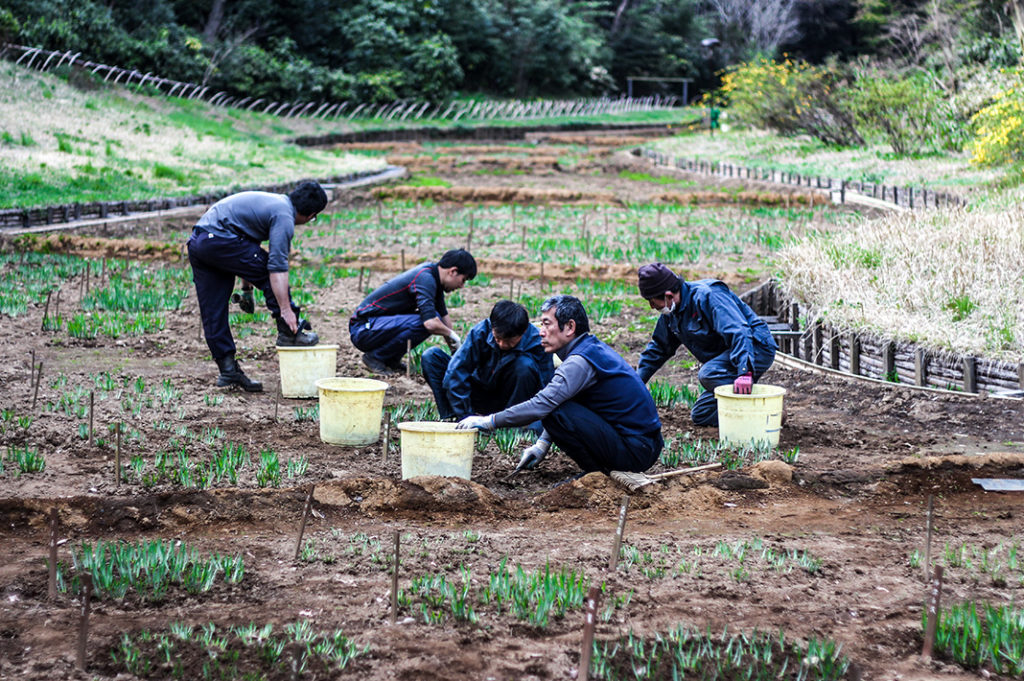I look on as a group of five groundskeepers silently go about their work. They are squatting next to buckets, holding curious tools and digging in soil that has been turned and trodden a thousand times before. A gentle breeze ruffles the wall of trees and the occasional bird song dances through the otherwise silent scene. It’s hard to believe that such tranquility could exist in one of Tokyo’s most lively suburbs, but the Meiji Jingu Inner Garden is as real as it gets. This secret garden lies within the Meiji Jingu Shrine complex, one of Tokyo’s busiest tourist destinations. Hundreds, if not thousands, traipse through the expansive grounds every day, yet this garden remains relatively unknown. I myself had visited on almost ten occasions before spotting the rather nondescript entrance along the main pathway.

Touring the secret garden
As with many places in Japan, the land underfoot has changed hands a few times. In relatively recent times (the 1600s) it belonged to wealthy political figure Lord Kato of Kumamoto. Though it wasn’t until the Meiji Period, a few hundred years later, that the garden became Imperial property.
My map leads me to a gorgeous Japanese tea house, commissioned for Empress Shoken by her husband, Emperor Meiji. From those rooms, she could look out the windows, over the grassy lawn toward the vast Nan-chi pond.
I follow the direction of her gaze and come upon a gnarled old pine tree leaning out over the water, held up by a series of wooden supports. Below the vast surface, a community of turtles and koi carp swim about seeking shelter under the pier and waterlilies.
There are plenty of places to sit and enjoy the scenery, including a thatched gazebo in a secluded corner to the left. Sitting here, contemplating nature, there’s really nothing to do but relax.
Iris Garden
I follow the path along the Nan-chi pond and eventually come to the Iris garden, said to have been one of the Emperor and Empress’ favourite spots on the grounds. With over 150 species and 1,500 plants, it’s a must-see for any plant lover.
It’s March when I first visit; the Iris have been planted and will be cared for by the groundskeepers until they bloom in three months’ time. (And beyond, for that matter.) My return in June is timed perfectly and I’m greeted by a sea of flowers ranging from white to vivid purple.
All around, people admire and photograph the iris, testament to the great work of the garden staff.
The power of nature
The Iris garden isn’t the only nature of note, though. The trees surrounding the entire space form a stunning, lush wall of deep green. Interestingly, some are Maples, meaning that an Autumn visit would be one of fiery fall colour. And we cannot forget the Azalea garden, blooming in late April, which contains some trees aged over 100 years old.
For my final stop, I follow the path to the farthest corner where the garden’s official “power spot” lies. Kiyomasa’s Well is a famous relic of the Edo Period, said to recharge and refresh anyone who simply takes a quiet moment there. I wait in a short queue and tiptoe across the stepping stones to peer down into the crystal clear water. The engineering of the well is impressive, funnelling pure water along to feed the Iris and the pond. But it’s the shady trees and the cool breeze off the gently trickling water that recharges me and gets me ready to face the crowds again.
Since my first visit to the Meiji Shrine Inner Garden, I have returned another three times or so, each presenting a different sight, smell and perspective from the one before it. One thing I can always count on though, is a peaceful sanctuary away from the crowds. It is a tonic for the soul after a busy sightseeing schedule. And considering Meiji Jingu and the adjacent Yoyogi Park are both free of charge and naturally beautiful, combining all three is the cheapest therapy going around.
Name: Meiji Jingu Inner Garden (Meiji Jingu Gyoen)
Open: 9:00am until 4:30pm, 7 days per week.
URL: https://www.meijijingu.or.jp/en/whattosee/garden/
Post by Japan Journeys.